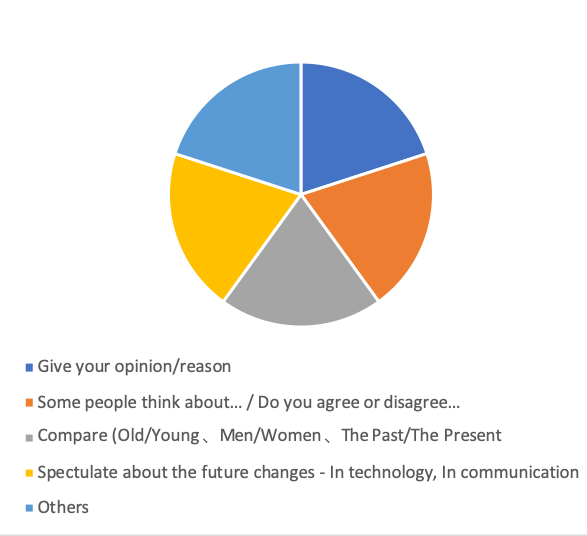当前位置:首页 雅思学习 全年考情回顾 | 2023年度雅思口语考情分析
发布时间:2024-01-17 关键词:雅思口语
摘要:为了2024可以有更好的表现,我们也需要好好总结一下2023口语考题,了解雅思口语上的变化趋势。现在我们从Part 1、Part 2/3逐步入手,给小烤鸭们详细解析2023雅思口语考情,并提供一些策略直击备考痛点。
为了2024可以有更好的表现,我们也需要好好总结一下2023口语考题,了解雅思口语上的变化趋势。现在我们从Part 1、Part 2/3逐步入手,给小烤鸭们详细解析2023雅思口语考情,并提供一些策略直击备考痛点。希望能帮助还没分手的小烤鸭们2024屠鸭成功。
一、口语考试part 1

2023雅思口语Part 1数量一览表
part 1部分总体维持在33-34题,其中物品类和事件类话题占大多数,人物和地点类则占比较少。
反观于人物和地点类话题的简单,物品和事件类话题占比提升,也在一定程度上加大答题难度。拿2023年9-12月题库季来举例,fishing/ robots/ noise/ fixing/ geography/ musical instruments等让很多学生觉得答题难度较大。不过,越是难题,越要有稳定的心态去面对。同时,也要掌握答题技巧来帮助自己更容易的答题。
在这里,也给大家分析一个常用的part 1答题技巧—“5W1H”。“它包括了:What/ When/ Where/ Who/ Why/ How/ How much/ How long/ How often。
这些拓展角度非常适用于和事情相关的part 1小问题,比如:
Have you ever lost your purse?
Do you remember the last time someone cooked for you?
Have you ever bought bag as a gift for your friends?
鉴于这一类的小问题也会融入“人、物、地”的元素,除了“5W1H”外,我们也可以选取这三类对应的角度来拓展细节。
Q1: Have you ever lost your purse?
Answer: Yes. I remember it took place a year ago (When). When I traveled to Japan, I left my favorite Gucci purse in a taxi (Where). I tried to find them by calling the taxi company, however, they hadn’t found any (How). It made me really depressed.
Q2: Do you remember the last time someone cooked for you?
Answer: Yes. It was my boyfriend who cooked for me to celebrate our first anniversary (Why). In order to prepare for the surprise, he rented a small apartment with a nice kitchen (Where). Even though he is not good at cooking, it was an unforgettable meal for me.
Q3: Have you ever bought bag as a gift for your friends?
Answer: Yes. Last year, I bought a handbag from Chanel for my best friend, Emily (When+What+Who), who loves to collect different types of bags (Why). It cost me a fortune, but it was worth it, because when she received it, she was on cloud nine (How much).
所以同学们在准备雅思口语Part 1中,可以不断的联想“5W1H”来增加更多的细节拓展点。但是最重要的是开口练习。所以同学们不能一味的看重词汇而忽略了语言沟通的本质。
二、口语考试part 2

2023雅思口语Part 2数量一览表
从一览表可以看出事件类和物品类Part 2话题占大多数,人物类和地点类话题相对较为稳定。虽然题目多,但烤鸭也不必慌张。只要你多观察,你就会发现一些出题规律。而我所指出题规律,不是在于标题,而是下面的4个follow- up questions。
多数同学在过去的学习中会忽略这些小问题的重要性,甚至认为他们不重要。但你要相信任何事物的存在都有自己的意义,既然雅思官方给了这些小问题,他们就已经帮大家安排了答题脉络。
同时,只要你观察仔细小问题,你就会发现同一类型话题都有非常固定的问题方向。既然如此,你也只需整理一些常规小问的答题规律即可。
拿人物类话题举例
从历年题库来看,超过90%的人物类话题都有相似的问题结构,一般表现为:
Describe a….person
Who the person is
How you know (about) the person
What
Why/ how you feel about
同时你要注意,相同的小问题有着一样的解题逻辑。所以我们需要明确每个小问题背后的答题原理,从而让你可以举一反三。这其实也是让你“从0-1编故事”变成“从0.5-1创造故事”的过程。
这里拿“How you know about…”类型问题来举例。该小问会出现在90%的话题当中,除了人物类话题,地点/物品/媒介/活动类话题中都会应用到该解题框架。
该问题的解题框架为【认知过程-目前结果】,可细分为三个步骤。
Step one: 你第一次是怎么知道的(哪个时间点?通过谁?或者从哪里获悉的?)
Step two:你对他的初次印象(初步了解到什么),并且你是否有第一时间就被他吸引到,还是刚开始不感兴趣,后来才产生的兴趣。
Step three: 当你初次了解到并产生兴趣后,接下去如何进一步去了解(线上?线下),再是最后你跟他的关系(身边的人:成为朋友; 明星:成为粉丝)
举例:
How do you know your neighbor?
Step one: I remember the first time I met him was when I moved to my new apartment.
Step two: He came to help me carry my heavy suitcases. I was touched and even invited him to have a meal at home. During the conversation, we found out we had a lot in common.
Step three: We added each other on WeChat and keep in touch online. Gradually we became friends and hang out regularly.
How do you know about the city (eg. Hangzhou)?
Step one: The first time I heard about the city was when I was a little girl.
Step two: My grandpa told me a beautiful story which took place there. I was intrigued by it completely. He told me the story over and over again and I never got bored of it.
Step three: I knew one day I would visit and 4 years ago I finally got the chance to go and it was as magical as I thought it would be.
有了结构之后,你就会发现之后只要在话题中出现了此类的小问题,你就可以直接套用结构、句型和词汇来帮助自己答题。这样做的效率一定会超过你背题。
三、口语考试part 3
Part 3应该是三个部分里最有挑战性的。很多年前,烤鸭中流传着这么一种说法:“Part 3是加分项!只要part1和part 2答好就可以”。或者在多年以前,我苟且都够认同这种说法,但现在它已经完全不符合当下的打分趋势。

现如今,考官开始疲于学生的part 2回答。背题司空见惯,这就无法检测出学生真实的口语能力。也正是如此,考官开始从part 3来挑战学生,来验证学生真正的英语实力。所以在现如今,你如果只练part 2,你想要达到口语6以上已经非常困难。
Part 3的准备又该怎么进行,我觉得它的出题点还是相对较为稳定的。主要包括以下:
人物类核心考点:
quality 品质
地点类核心考点:
1.big city vs small city
2.House vs flat
3.protection of Historical building
4.Benefits and drawbacks of tourism
5.Transport (public transport vs private cars; the improvement of transport)
活动类核心考点:
benefits and drawbacks brought by activities/ skills
媒介类核心考点:
benefits of reading
Types of books/ movies/ adverts
gender difference
事件/物品类核心考点:
age difference
Time difference
这些虽然只是part 3中的一部分,但掌握了这些点就可以灵活应用在更多的part 3问题里。所以和part 2一样,学会寻找规律,总结答题技巧,才能让自己事半功倍。